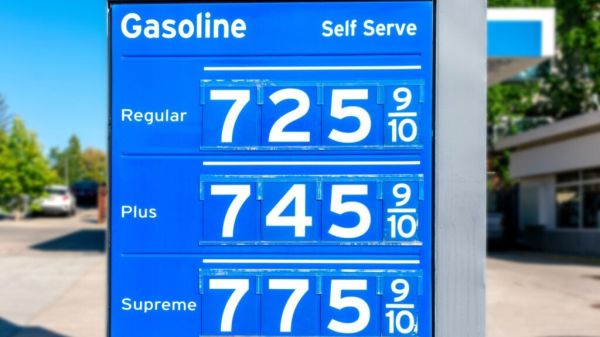Gas prices can be a head scratcher. If you’ve ever wondered why gas stations have different prices, you’re not alone. Also, if you’ve ever filled up your tank and wondered why the sign says $3.49 9/10 instead of just rounding up to $3.50, then get in line. That awkward little 9/10 of a cent has been around so long it feels invisible. No, it’s not a typo, and it’s definitely not random. It’s actually a weird, archaic quirk. That fractional penny is both a relic of history and a psychological pricing trick that refuses to die.
Gas prices almost always include 9/10 of a cent because of a 1930s tax law. It continues to exist thanks to the lasting mix of psychology, competition, and tradition. The practice dates back nearly a century. It is rooted in federal gasoline taxes introduced during the Great Depression. What started as a practical accounting measure morphed into one of the most stubborn quirks in modern commerce. Consumers may grumble about it, but gas stations keep doing it because it works — at least for their bottom line.
When did gas stations start doing it, and why
The nine-tenths of a cent gas price story starts in the 1930s. Then, the government introduced a gasoline tax. This tax was 1 cent per gallon. But it came at a time when gas often cost less than 20 cents per gallon. So that tax was a big deal. Retailers responded by advertising gas prices down to the tenth of a cent, making every fraction seem like savings. If you were charging 15.9 cents instead of 16 cents, that tiny difference could lure customers into your station. The fractional cent was all about marketing spin. Once pricing signs became accustomed to include tenths of a cent, the system stuck. Even when time went by, and gas prices rose into the dollars-per-gallon range, it persisted. The fraction became less meaningful but far more entrenched.
By the 1950s and 1960s, oil companies realized consumers were psychologically drawn to lower-looking prices. A price ending in .9 was easier on the brain than a rounded-up number. They basically took a page out of the broader retail playbook. You know the ones that say $19.99 shirts or $999 laptops. Today, that 9/10 of a cent isn’t about taxes anymore, even though gas prices are going up. It’s about perception. It transforms $3.50 into $3.49 in the mind of a driver, even though no one’s ever getting change for a fraction of a penny. It’s the most enduring example of psychological pricing at scale.
Why gas stations refuse to drop it
Gas stations have evolved over time. If you really think about it, old gas stations were way better than what we have now for various reasons. One quality they still do share with modern gas stations is the 9/10 of a cent. Given how outdated the practice seems, modern gas stations still don’t just round up. This is due to competition and margins. Most gas stations make little profit from selling gasoline itself. They often only gain a few cents per gallon. Their real money comes from what you buy inside the store. The coffee, chips, and even lottery tickets. But when every station on the block is competing for your attention, that tiny 0.9 difference matters.
If one station dropped the 9/10 and posted $3.50 while the one across the street stuck with $3.49 9/10, customers would gravitate to the lower number. This is despite the real difference being pennies per tank. Gasoline pricing is hypercompetitive, and stations don’t want to risk looking more expensive. If everyone else is keeping the 9/10, no single retailer wants to be the first to change.
There’s also the matter of signage and uniformity. Pumps, regulators, and pricing boards are set up to display tenths of a cent. Changing the system would require reprogramming and, more importantly, changing consumer expectations. That’s a lot of effort for something that doesn’t actually hurt sales. So, from a business perspective, the 9/10 fraction is still doing its job of making customers think they’re getting the better deal.










